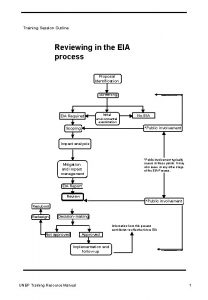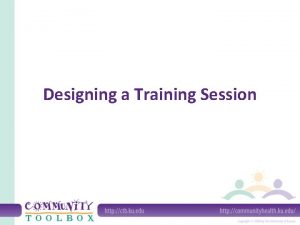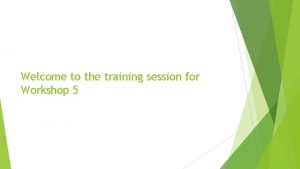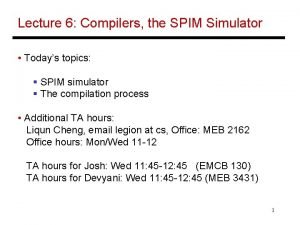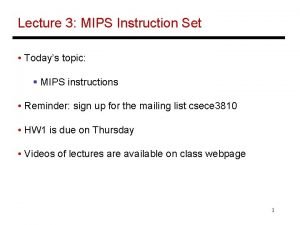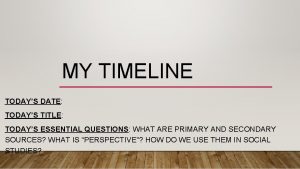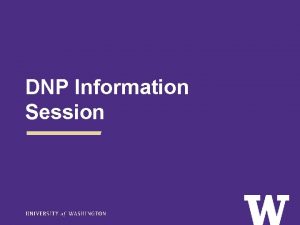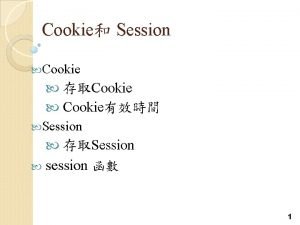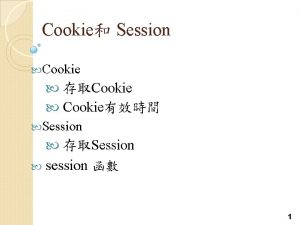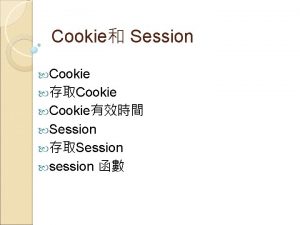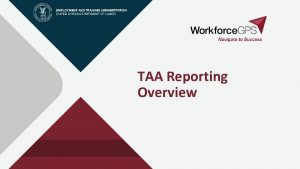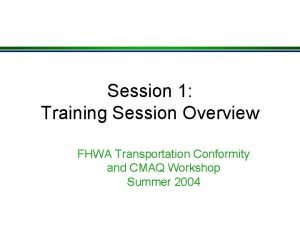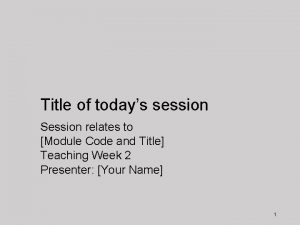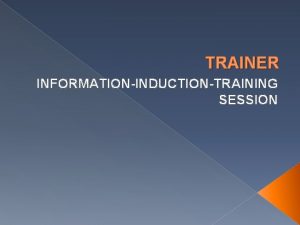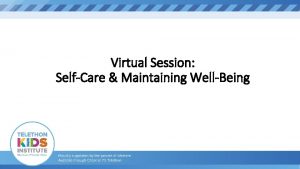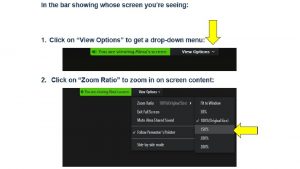2 nd Training Session Overview of Todays Training


















- Slides: 18

2 nd Training Session

Overview of Today’s Training ▹ Recap from 1 st Training ■ Position Paper ▹ Motions & Points ▹ Basics of Resolution Paper ▹ Working Paper/Draft Resolution ■ Preambulatory Clauses ■ Operative Clauses 2

Introduction: Introductory sentence providing an overview of the topics and if appropriate, your delegation’s relationship with the committee. Position Papers Paragraph 1: Background information on the topic, why your country thinks it is important, relevant national commitments and action in issue. Remember to focus on the national policies that influence your country’s action on this topic within the UN and internationally. 3 Paragraph 2: International commitments and your country’s support of specific past resolutions, initiatives, conventions and treaties. Describe what actions have been taken by your country to address prior international agreements made by your country. Paragraph 3: Specific and concrete proposals for next steps on the topic, priority issues, and how your country can move forward on addressing the topic. This is the most important section of the position paper, and should be the longest paragraph.

“ MOTIONS & POINTS 4

● ● ● Basics of a Resolution ● ● Do not have resolutions prepared beforehand!! When resolutions are first drafted, they are called working papers; Once working papers are approved by the Dais, they become draft resolutions; Structured as follows: o Heading o Preambular Clauses o Operative Clauses Resolutions are comprised of multiple clauses; Resolutions do not contain any periods until the last clause, but instead are one sentence with semicolons and commas separating each clause; Multiple draft resolutions can be adopted on the same agenda item, which represent the final outcome documents of the committee on an agenda item. 5

SIGNATORIES AND SPONSORS 6

Preambulatory Clauses: • The preamble of a draft resolution states the reasons for which the committee is addressing the topic and highlights past international action on the issue. Each clause begins with a present participle (called a preambulatory phrase) and ends with a comma. All clauses must clearly define the terms being used. Preambulatory clauses can include: • References to the UN Charter; • Citations of past UN resolutions or treaties on the topic under discussion; • Recognition of the efforts of regional or nongovernmental organizations in dealing with the issue; and • General statements on the topic, focusing on its significance and its impact. • Structured from most general to most specific • Begin with Preambulatory Phrase • No numbering • Commas after each line • Spacing after each line 7

• Having received • Affirming • Expecting • Alarmed by • Emphasizing • Approving • Expressing it’s appreciation • Bearing in mind • Fulfilling • Believing • Fully aware • Confident • Emphasizing • Contemplating • Expecting • Convinced • Fulfilling • Declaring • Fully aware • Deeply concerned • Further deploring • Deeply conscious • Further recalling • Deeply convinced • Guided by • Deeply Disturbed • Having adopted • Deeply Regretting • Having considered • Desiring • Having examined • Keeping in mind • Noting with deep concern • Nothing with satisfaction • Noting further • Observing • Reaffirming • Realizing • Recalling 8 • Recognizing • Referring • Seeking • Taking into consideration • Taking note • Viewing with appreciation

The Human Rights Council, Recognizing the 1945 Charter of the United Nations, which states that all Member States have the right to state sovereignty; the Universal Declaration of Human Rights (UDHR), which defines and promotes the universal rights granted to all people; and the 1951 Convention and Protocol Relating to the Status of Refugees, which defines refugee status and right, Guided by the General Assembly (GA) resolution 66/176, which encourages Syrian cooperation with Human Rights Council (HRC), Emphasizing the importance of partnering with other United Nations (UN) bodies including the UNHCR and UN Habitat, Reaffirming its faith in the continued cooperation between the HRC and Security Council (SC), including the SC’s integral role in mediating the human rights issue in Syria, Bearing in mind the role of investigations by the International Criminal Court (ICC) to gather intelligence of human rights violations, 9

Operative Clauses • Operative clauses offer solutions to issues addressed earlier in a resolution through the preambulatory section. These clauses are action oriented and should include both an underlined verb at the beginning of your sentence followed by the proposed solution. Each clause should follow the following principles: • Clause should be numbered; Operative Clauses: • Most specific to general • Numbered • Semicolons after each line • Each clause should support one another and continue to build your solution; • Spacing after each line • Add details to your clauses in order to have a complete solution; • Full stop/period at the • Operative clauses are punctuated by a semicolon, with the exception of your last operative clause which should end with a period. end 10

• Accepts • Encourages • Affirms • Endorses • Approves • Expresses its appreciation • Authorizes • Expresses its hope • Calls • Further invites • Calls upon • Deplores • Condemns • Designates • Confirms • Congratulates • Considers • Further recommends • Further requests • Further resolves • Has resolved • Notes • Proclaims • Draws the attention • Emphasizes • Encourages • Reaffirms • Recommends • Regrets • Reminds • Requests • Endorses • Declares accordingly • Expresses its appreciation • Deplores • Expresses its hope • Designates • Further invites • Draws the attention • Further proclaims • Emphasizes • Further reminds • Solemnly affirms • Strongly condemns • Supports • Takes note of • Transmits • Trusts 11

1. Encourages cooperation between HRC, UNHCR, SC, related NGOs, and Member States hosting Syrian refugees to facilitate diplomatic discussions on ensuring refugee rights: a. Occurring voluntarily in Geneva, Switzerland within the next 6 months; a. Centered around granting basic living standards current with international human rights conventions and laws; 2. Encourages the UN Arab League Special Envoy to continue its mission in promoting talks between Russia, the United States and Syria, and would like to also see the following alterations to the envoy’s current mandate: a. The reduction of armed violence in all forms, as opposed to the complete cessation of violence; a. On Point 1 of the Six Point Plan, the inclusion of NGOs in dialogue with the Syrian people; 3. Invites the assistance of NGOs working with the Office for the Coordination of Humanitarian Affairs (OCHA) to address the immediate medical concerns of refugees affected by the Syrian Crisis and improve the living conditions within pre-existing refugee camps; 12

AMENDMENTS 13

AMENDMENTS 14

DRESS CODE 15

Ice Breaker: Practicing Speech Skills 16

17

Total Cost: $280 (includes $100 initial payment) 18
 Training session outline
Training session outline Facilitate learning session meaning
Facilitate learning session meaning Training session design
Training session design Welcome to the training session
Welcome to the training session How to introduce yourself in training session
How to introduce yourself in training session Opening prayer for training session
Opening prayer for training session Todays generations
Todays generations Today's class was amazing
Today's class was amazing Todays with apostrophe
Todays with apostrophe Todays worldld
Todays worldld Whats todays temperature
Whats todays temperature Todays globl
Todays globl Todays wordlw
Todays wordlw Chapter 13 marketing in today's world worksheet answers
Chapter 13 marketing in today's world worksheet answers Todays plan
Todays plan Todays sabbath lesson
Todays sabbath lesson Sabbath school welcome
Sabbath school welcome Walsall rfc
Walsall rfc Todays health
Todays health
